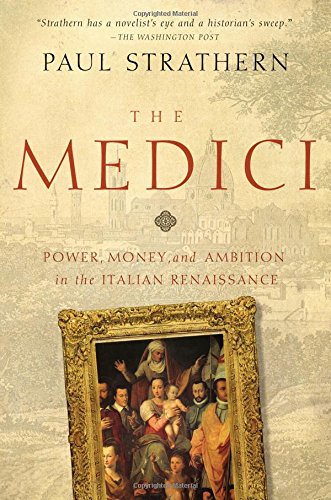
The Medici
Italian Histories
کتاب های مرتبط
- اطلاعات
- نقد و بررسی
- دیدگاه کاربران
نقد و بررسی

February 22, 2016
In this absorbing follow-up to his beautiful Death in Florence: The Medici, Savonorola, and the Battle for the Soul of a Renaissance City, Strathern chronicles the legendarily farsighted banking family, offering a cautionary tale of arrogant and greedy heirs who bankrupted themselves and their city, thus destroying a largely symbiotic relationship. Florence was the birthplace of the Renaissance, with the clever and powerful de Medici family serving as its midwives through various acts of patronage and their elevation of artists such as Michelangelo Buonarroti, Leonardo da Vinci, and Sandro Botticelli. Strathern opens with a thrilling account of an assassination attempt on Lorenzo the Magnificent, allowing this fast-paced vignette of skill, luck, and treachery to color the family's astonishing rise and fall. Many historians concentrate on the figures of Cosimo and Lorenzo; both are well rendered here, as are the viewpoints of Pope Leo X, the family's unlikely war hero, and his relative and successor, Clement VII, who wrestled with Henry VIII's "great matter." Most of Strathern's portrayals are sympathetic in their context, though odd suggestions occur, particularly the implication that strong female influences led to several Medici men being gay. Nevertheless, this gratifying and comprehensive family saga sheds light on both the internal workings of a remarkable family and on how a singular family irrevocably influenced Western civilization.

Starred review from December 1, 2015
The prolific author continues to do what he does best--bring history to wondrous life--with this thorough history of the Medici family, the stimulus and backbone of the Renaissance. Strathern (Death in Florence: The Medici, Savonarola, and the Battle for the Soul of a Renaissance City, 2015, etc.) begins this bright, novelistic history with the 14th-century banker Giovanni di Bicci, who laid the groundwork for his family's wealth. The Italians invented banking and double-entry bookkeeping, and to avoid accusations of usury, Giovanni charged only a percentage for "risk." Eschewing politics, he concentrated on building wealth. It was his son Cosimo who took advantage of the erudite refugees from the fall of Constantinople to promote ancient Greek and Roman writings. He supported the arts and began dominating Florentine politics. Cosimo ruled without appearing to rule, with the family always supporting the working class. In addition to economics lessons, Strathern provides wonderful thumbnail sketches of the great artists and writers of the time. One of the Medici's best moves was supporting the papal candidates, realizing that having the popes' backing, as well as their lucrative banking, would provide strength. Through unrest, church schisms, invasion by the Holy Roman Empire and France, the Medici flourished, none more so than the flamboyant Lorenzo. This was the time of Savonarola, the fiery anti-humanist, but also Botticelli, Brunelleschi, and Machiavelli. The strength of the Medici continued with the papacies of Leo X and Clement VII. The author dubs the Medici godfathers to the Renaissance, but it was Clement's dawdling over the divorce of England's Henry VIII that unwittingly led to the final break with the church and the Reformation. The ladies of the family played their own parts, with Catherine de Medici dominating the Valois of France, followed to the throne by her cousin Marie. A fantastically comprehensive history covering the breadth of the great learning, art, politics, and religion of the period.
COPYRIGHT(2015) Kirkus Reviews, ALL RIGHTS RESERVED.

January 1, 2016
As bankers and statesmen, cardinals and scholars, reprobates and royalty, the Medici family left an indelible mark on European history and culture. With financial power deriving from a vast banking empire, Medici descendants at various times were among the richest people in the Western world. It is a lineage that produced two popes and two queens of France, along with a fair share of degenerates and schemers. Whether in power or in exile, the Medicis were at the heart of the golden age of Florence and the Italian Renaissance, as well as the regional squabbles, maneuvering, and political instability that characterized the period. Strathern (Death in Florence) succeeds in tracing the history of this intriguing clan from its unexceptional beginnings to an ignoble end in a compelling and readable style. VERDICT What might have been a bewildering string of names, places, and dates is instead a page-turning popular history of an ambitious and influential family. Highly recommended to anyone with an interest in history.--Linda Frederiksen, Washington State Univ. Lib., Vancouver
Copyright 2016 Library Journal, LLC Used with permission.

























دیدگاه کاربران